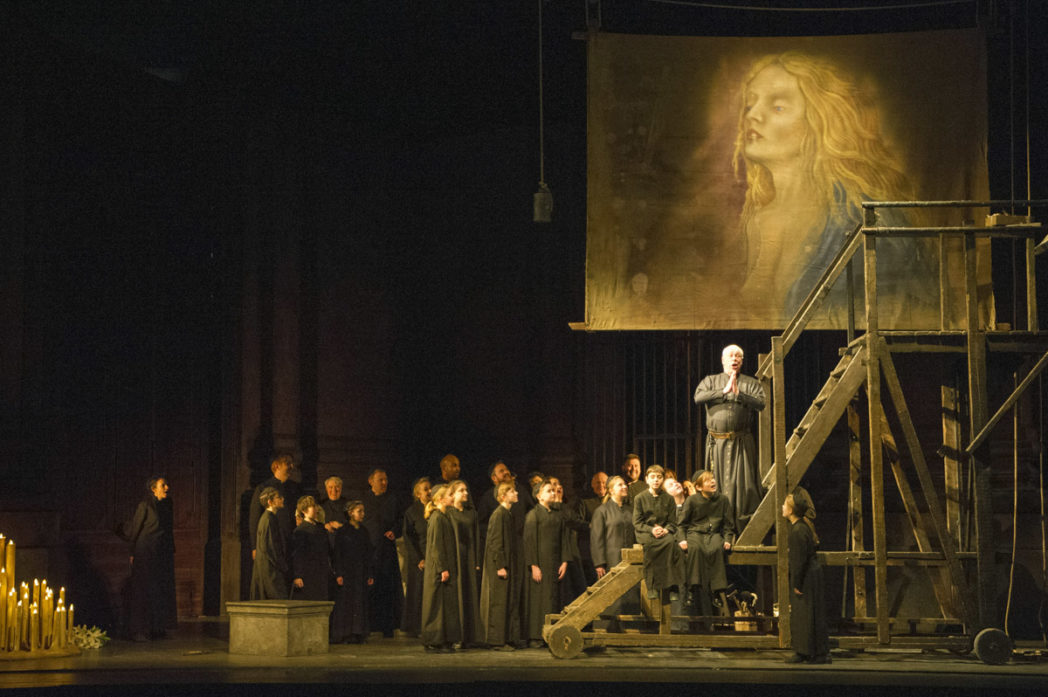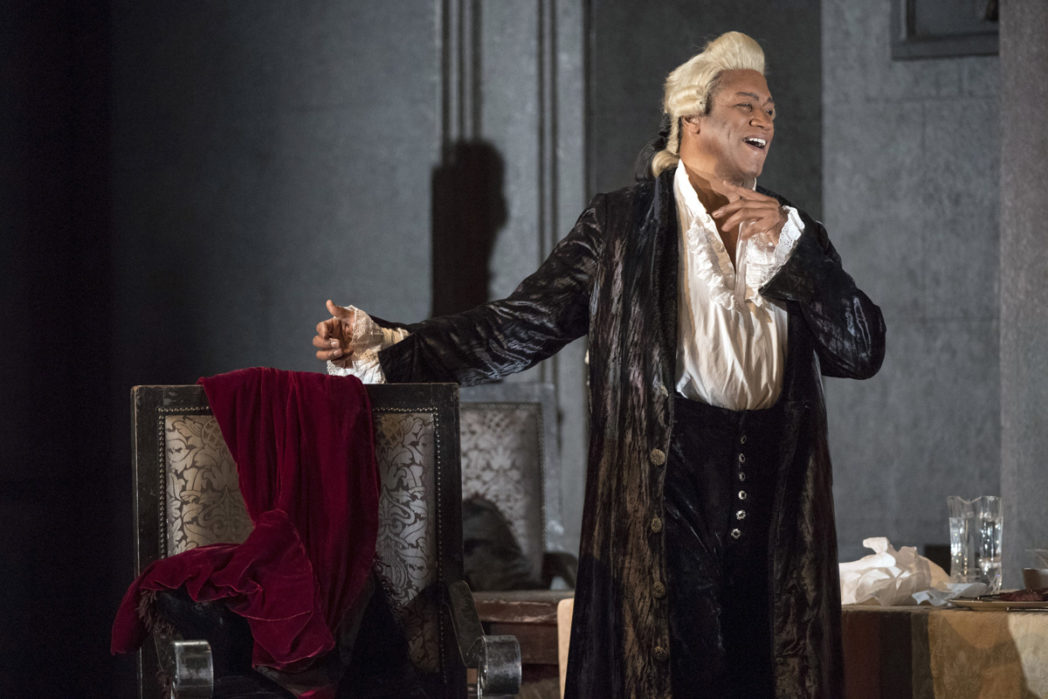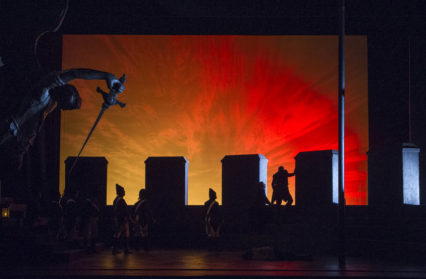David Truslove attends the latest revival of Puccini’s Tosca from Welsh National Opera, a well-paced and well-acted rendition of the classic opera.
Giocomo Puccini claimed that the success of a theatrical production depended on the achievement of three laws: ‘to interest, to surprise, to move’. In this latest revival of Welsh National Opera’s Tosca these rules are admirably fulfilled, albeit in varying degrees. One of the strengths of this staging, first aired over twenty-five years ago in 1992 and now rebooted by Benjamin Davis, is the recognition that this work carries its own indestructible dramatic force, its gritty realism needing little or no directorial tinkering.
Mercifully, its original director Michael Blackmore has not sought to reinvent Tosca as a vehicle for contemporary riffs on abuse, betrayal and power, nor pursued any concept-driven visual distractions in order to pour new wine into old bottles. Instead, this is a traditional no-frills, conventional presentation, which allows the work’s characters to carry the plot unaided and for its emotional weight to speak for itself.
I caught the second of two helpings of Puccini’s Tosca at Southampton’s Mayflower Theatre (one of several venues on WNO’s two-month tour) where its expansive stage was shrunk to more practical and theatrically compact proportions. This still allowed plenty of room for a plainly furnished Sant’Andrea della Valle (dominated by a moveable staircase), a palatial residence in the Palazzo Farnese (elegantly offsetting the horror of a concealed torture chamber) and the Castel Sant’Angelo’s parapet lit against a baleful sky and evoking for me one of those apocalyptic canvases by the visionary artist John Martin.
These handsome, if now ageing sets, courtesy of designer Ashley Martin-Davis, provide considerable Roman verisimilitude (as do the period costumes) in step with the historical timeframe of Napoleon’s Italian ambitions around 1800 and the period in which French dramatist Victorien Sardou sets his five-act La Tosca.

Straightforward and unfussy sets they may be, they also inhabit a subtle symbolic dialectic. Hints of idolatry, both sacred and profane, are encoded into the church’s giant crucifix and portrait of Mary Magdalene, while Baron Scarpia’s apartment indicates an explicit conflict of good and evil in its display of crucifix and plinth-mounted devil with horns – details gently sketched in and without the glare of someone telling you what to think. Not so subtle is the sword of Damocles looming over proceedings prior to Cavaradossi’s execution; its emotionally-charged image of imminent peril made redundant by Angelotti’s dead body still tied to a post.
Although dramatically limp, the castle scene is aided and abetted by Benjamin Naylor’s atmospheric lighting. While at times this failed to illuminate facial expression, it was ideal for casting shadows and silhouettes (Scarpia’s shadow followed him around to sinister effect) and underlining the impending tragedy that befalls all three central characters.

Casting was superb with all three central protagonists persuading on equal terms. American soprano Mary Elizabeth Williams (who made her WNO debut in this role back in 2013) excels as a devout and feisty Tosca, comfortably portraying a playfully jealous lover with a need for assurance that no other woman’s eyes are finer. Her singing impressed too, and she gave a well-projected, intelligent interpretation that combined silk-lined radiance with power. A melting ‘Vissi d’arte’ was followed by singing of passionate intensity when later confessing to Scarpia’s murder.
She is well-matched vocally by the ringing tones of Gwyn Hughes Jones as Cavaradossi whose somewhat ponderous demeanour belies a fabulous vocal apparatus which carried him effortlessly from ‘Recondita armonia’ to ‘E lucevan le stelle’ – warmth and strength of tone in abundance and the ability to hang on to high notes and milk them for all their worth. Chemistry between them was generally convincing as were the confrontations with Mark S. Doss, the brutal Scarpia whose indifference to pain and emotion, and lust for violent conquest, was mirrored in an authoritative and rich timbre.
Other strong performances included a well-drawn Daniel Grice as the luckless political prisoner Angelotti, Donald Maxell as a comic Sacristan, Michael Clifton Thomson as a chilling Spolletta and Rosie Hay as a mellifluous Shepherd-boy. The WNO chorus and local children brought robust singing to the papal procession, darkly lit and all the more disturbing for the curious Ku Klux Klan headwear.
At the helm of this well paced account was conductor Timothy Burke who drew sumptuous and expressive playing from the WNO orchestra (a luminous cello quartet in Act Three was particularly fine) and propelled the work with an intensity of spirit entirely fitting for this enduring tragedy. If, on occasion, balance was not always perfect (the Mayflower has no proper pit) the opulent scoring underlined one reason why Puccini’s music never fails to ‘to interest, to surprise, to move’.
Tosca – Puccini
WNO Chorus & Orchestra
Conductor – Timothy Burke
Director – Michael Blakemore
Revival Director – Benjamin Davis
Designer – Ashley Martin-Davis
Lighting Realised on Tour – Benjamin Naylor
Tosca – Mary Elizabeth Williams
Cavaradossi – Gwyn Hughes Jones
Scarpia – Mark S Doss
Angelotti – Daniel Grice
Sacristan – Donald Maxwell
Spoletta – Michael Clifton-Thompson
Sciarrone – George Newton-Fitzgerald
Gaoler – Jack O’Kelly
Shepherd Boy – Rosie Hay
Sung in Italian with English surtitles
Header photo by Richard Hubert Smith
David Truslove is a regular contributor to Wales Arts Review.
You might also like…
Cath Barton revisits a Kennedy era White House as she casts a critical eye over Welsh National Opera’s timely revival of their acclaimed production, Verdi’s Rigoletto.












